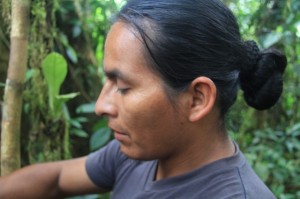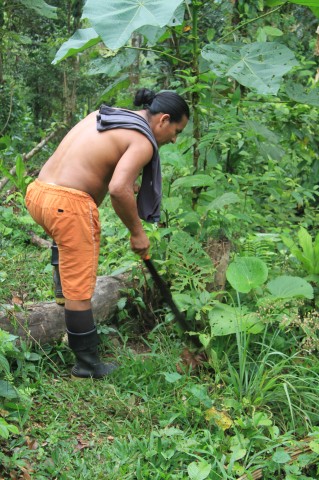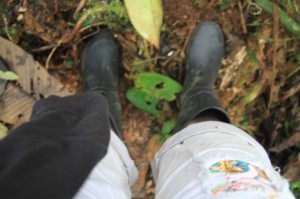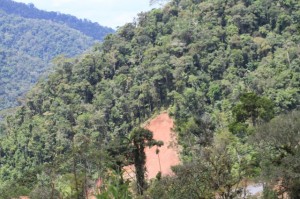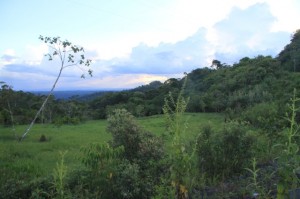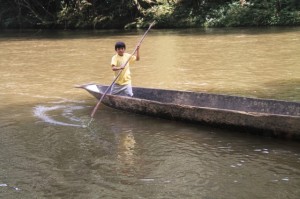There are a few things to note when venturing into the Amazon Jungle in Ecuador:
*It rains a helluva lot.
*It’s wet a helluva lot.
*There a helluva lot of bugs.
*There are a helluva lot of unknown creatures you may encounter and a book with their photos won’t necessarily help you
*You get a helluva of mosquito and other insect bites despite how much deet you put on.
*The jungle noises at night will either put you to sleep or scare the living daylights out of you.
*The chances of falling into a river are greater than you think.
*It’s really dark at night, and I mean really dark.
*Check your shoes outside your tent in the morning before you put them on to avoid squashing a lizard, spider or some unknown wiggly looking critter that may be in one.
*If you run across a village which is likely, know that you’ll be running into families with 15 or more kids and there are likely to be a lot of crying and screaming kids running around.
*River water doesn’t taste great at least in the Ecuadorian rainforest where oil companies and other western crap has infiltrated them.
*You may get Jungle Fever even if you head in with a stellar immune system – western blood ain’t all that familiar with the ebbs and flows of the climate.
*Gorgeous birds and more birds – everywhere.
*Flowers, plants, vegetables, medicinal roots and herbs – everywhere.
*Don’t expect wifi coverage or electricity (I had to say it as I ran into people who believed they might have it).
*It can be awfully muddy so don’t go in with a pair of hiking boots you’re not okay with turning a permanent brown.
There are various parts of the Ecuadorian jungle to explore. In the northeast, it tends to be muggier, hotter and more prone to not just Malaria but Yellow Fever as well. In fact, they won’t let you in without proof of Yellow Fever innocuation. It’s also a little harder to get to and isn’t as readily accessible from smaller town kick-off points like Puyo and Maca in the south.
Areas in the north I didn’t explore largely because of lack of time to update my Yellow Fever shot, include: (note, not all these areas require yellow fever)
* Baeza: This is an old Spanish missionary and trading outpost first founded in 1548. (plants and wildlife make it worth the trip, you can also go white-water rafting)
* San Rafael Falls: Past El Chaco, climb to the falls, which is a steep climb, but worth it as it is Ecuador’s largest falls. (get off the bug before the bridge crossing Rio Reventador)
Dureno: There’s primary rainforest here, roughly an hour from Lago Agrio. You can also find a Cofan settlement where you can find a guide to show you some jungle plants.
* Reserva Produccion Faunistica Cuyabeno: Rainforest that covers well over 6,000 square km not too far from Rio Cuyabeno. (you can pick up a tour in Quito)
* Nuevo Rocafuerte: A long trek from Coca along the Rio Napo (8-10 hours), this mysterious and beautiful adventure is on the Peruvian border. There’s not much infrastructure here so be prepared for a rougher than most experience.
* Parque Nacional Yasuni: Ecuador’s largest park wtih nearly 10,000 km of wetlands, marshes, swamps, lakes, rivers, and tropical rainforest.
* Parque Nacional Sumaco-Galeras: More cloud forest that you get to by taking what’s locally referred to as the Loreto Road. You can stay at the Yachana Lodge here. There’s over 2,000 km of rainforest, hidden caves and cliffs, as well as Volcan Sumaco at 3,732 meters. Note: It’s WET, so be prepared with ponchos and gortex or other such waterproof hiking boots.
* Tena: Waterfalls, petroglyphs, jungle and indigenous communities is what brings people here. Be sure to check out rivers Rio Tena and Rio Pano and there are plenty of accommodations.
In the south, there are a number of 3 to 7 day excursions you can do with an organized tour and a guide. Because you’re venturing into preservation territory, they frown upon going into these areas solo and frankly, it’s not that easy to do since there really isn’t any traditional accommodation and camping in the middle of the jungle without knowledge of the wildlife, birds, plants and insects isn’t all that wise. For the southern points of the Oriente, most have to go through Macas, which is a dusty little town with limited accommodations and restaurants. (Note: the chinese restaurant in town has the best food and is clean but you rarely see anyone there….I ate there twice and on both occasions, wonder how they stay in business).
* Parque Nacional Sangay: Alpine lakes, Sardini YAca lagoons and wildlife. You can get there via bus from Macas.
* Kapawi Ecolodge & Reserve: Located in Achuar wildness, it’s a fairly remote part of the Ecuadorian Amazon. Kapawi offers ecologically and culturally interesting experiences. I wish we had opted for a lodge rather than a tent in hindsight, mainly because of the rains not the camping experience itself which was fine.
* Gualaquiza: Tihs town with a population of under 10,000 is spread against a sloping hillside surrounded by beautiful jungle landscape. Check out the bus station market for citrus, yuca and chamomile. Accommodation is tough in this town; main reason to go is to get out into the jungle.
Since most guides out of Banos, Puyo or Macas cater to the more adventure traveler (take note: NO luxury), they tend to plan tours for groups rather than one or two people. We lucked out, or so we thought, by landing an indigenous ‘naturalist’ guide who said he’d take us into a primary rainforest area to visit indigenous people and explore the jungle’s interior by canoe and by foot. Note: private transportation would be included we were told but instead of a wopping $35 a day, we would pay $55 instead, and add an additional fee of $50 for private one way the day before the tour started from Banos to Macas, so we’d be ready to dive in early the following day.
Enter an outfit called Rainbow Expeditions, led by German Shakay, from the indigeneous Shakay tribe, who was quick to show us his Naturalist License. Not all licenses are the same we later learned, so it’s important to really sus out their knowledge and more importantly enthusiasm for nature and animals before you sign on the dotted line. German goes by ‘Shakay’ – his native name. With high cheek bones, an angular jaw and long thick black hair which he often wears in a pony tail, he told us our options which all seemed very vague to me in hindsight and frankly at the time.
We also didn’t get a receipt for the tour, which I’d suggest you insist upon up front, with a very detailed list of what the tour includes for the price. If the space isn’t long enough to list everything, draw an arrow and manually add it yourself – you do not want to be left re-negotiating and going through the he said, she said scenario on day four of your tour. It turns out that he doesn’t have his own vehicle (and perhaps other tour operators don’t either and it’s just the status quo for tours out of Puyo and Macas), so he had to rely on outsourcing the private transportation and in our case, it ended up being Eloy, a buddy of his who works part time in Banos and part time in Macas.
Included in the tour we were told was private transportation to and from, meals, bottled water purchased from a store, lodging (a tent in a covered lodge-like structure with blankets, pillows, towels, essentially everything we would need) and guided tours with information each day about what we would see.
Enter the Ecuadorian style of doing things and an entire comedy of errors. Nothing is as it seems and the majority of the time, the estimate or quote you are given is a far cry from what actually happens.
In other words, if you are quoted $2 for a taxi ride, don’t be surprised if its $5 when you get to the other side. If you are told some things are included in the price, don’t be surprised if a third of those things don’t magically show up and when you question it, suddenly their English is poorer than it was the previous day. If you’re told that a flight leaves at noon, it may very well be 2 pm or later even though they keep telling you in 20 minutes every single time you ask.
This is of course not the rule but it happens often enough to take note.
Shakay knew quite a bit about the local jungle plants, particularly ones that could be used for medicinal purposes, including minor ailments like hayfever, acne and sinus issues, all of which we tested. Below he finds us various plants to use, taste, smell and see:
He did have a few pairs of long rubber boots to wear during jungle hikes. Strong recommend btw, mainly because of insects and mud. Even if you have sturdy hiking boots with good traction and are wearing pants, critters can get in – tall rubber boots to the rescue.
Shakay paints red ‘paint’ from the Chiote plant when we first arrived. He says this helps to prevent ‘foreigners’ from getting Jungle Fever when they first get to the jungle. Where he learned about the plants, trees and animals? From his grandfather on his mother’s side.
Below, on the way from Macas to the jungle village where Shakay’s family lives along the Macuma River:
On the Puyo to Macas Road:
A little boy picks us up in a hand-carved wooden canoe along the Macuma River to take us to the Yamaram Tsawa Village:
I took a substantial number of photos during various hikes through the jungle near his village to the southeast of Macas. Refer to this blog post for more.

Renee Blodgett is the founder of We Blog the World. The site combines the magic of an online culture and travel magazine with a global blog network and has contributors from every continent in the world. Having lived in 10 countries and explored nearly 80, she is an avid traveler, and a lover, observer and participant in cultural diversity.
She is also the CEO and founder of Magic Sauce Media, a new media services consultancy focused on viral marketing, social media, branding, events and PR. For over 20 years, she has helped companies from 12 countries get traction in the market. Known for her global and organic approach to product and corporate launches, Renee practices what she pitches and as an active user of social media, she helps clients navigate digital waters from around the world. Renee has been blogging for over 16 years and regularly writes on her personal blog Down the Avenue, Huffington Post, BlogHer, We Blog the World and other sites. She was ranked #12 Social Media Influencer by Forbes Magazine and is listed as a new media influencer and game changer on various sites and books on the new media revolution. In 2013, she was listed as the 6th most influential woman in social media by Forbes Magazine on a Top 20 List.
Her passion for art, storytelling and photography led to the launch of Magic Sauce Photography, which is a visual extension of her writing, the result of which has led to producing six photo books: Galapagos Islands, London, South Africa, Rome, Urbanization and Ecuador.
Renee is also the co-founder of Traveling Geeks, an initiative that brings entrepreneurs, thought leaders, bloggers, creators, curators and influencers to other countries to share and learn from peers, governments, corporations, and the general public in order to educate, share, evaluate, and promote innovative technologies.

